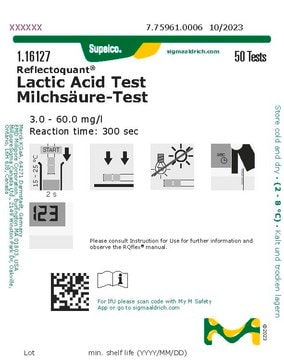MAK058
D-Lactate Colorimetric Assay
sufficient for 100 colorimetric tests
Synonym(s):
D-Lactate Test Kit
Sign Into View Organizational & Contract Pricing
All Photos(2)
About This Item
UNSPSC Code:
12161503
NACRES:
NA.84
Recommended Products
usage
sufficient for 100 colorimetric tests
application(s)
cosmetics
food and beverages
detection method
colorimetric
relevant disease(s)
neurological disorders; gastrointestinal diseases
storage temp.
−20°C
General description
D-Lactate, typically present in the bloodstream at nanomolar concentrations, is produced by an intestinal source or via the methylglyoxal pathway. In mammals, D-Lactate metabolism requires D-Lactate hydrogenase and is metabolized slowly, thus an increase in blood concentration levels can lead to acidemia and acidosis. The severity of this D-lactic acidosis can be associated with neurotoxic symptoms. Significant D-Lactate accumulations in the body can also be related to impaired metabolism and excretion.
Application
D-Lactate Colorimetric Assay kit has been used to determine the stereospecificity of lactate produced.
Suitability
Suitable for use with samples of serum, plasma, cells, culture and fermentation media.
Principle
In this assay, D-Lactate is specifically oxidized by D-Lactate hydrogenase and generates a proportional colorimetric product measured at 450 nm. The useful concentration range in samples is 0.1-10 mM D-Lactate.
Signal Word
Danger
Hazard Statements
Precautionary Statements
Hazard Classifications
Eye Dam. 1 - Skin Corr. 1B
Storage Class Code
8A - Combustible corrosive hazardous materials
Certificates of Analysis (COA)
Search for Certificates of Analysis (COA) by entering the products Lot/Batch Number. Lot and Batch Numbers can be found on a product’s label following the words ‘Lot’ or ‘Batch’.
Already Own This Product?
Find documentation for the products that you have recently purchased in the Document Library.
Customers Also Viewed
William H. Hoffman et al.
Journal of clinical research in pediatric endocrinology, 12(2), 160-167 (2019-09-14)
To determine the time relationships of soluble receptor for glycation end-products (sRAGE), [a decoy of the advanced glycation end-products (AGE)-RAGE axis] and D-lactate, (a metabolite of methylglyoxal) in the inflammatory response to diabetic ketoacidosis (DKA). Sixteen children and adolescents with
Ottavia Benedicenti et al.
Journal of fish diseases, 42(9), 1241-1258 (2019-06-18)
A relationship between increasing water temperature and amoebic gill disease (AGD) prevalence in Atlantic salmon (Salmo salar) has been noted at fish farms in numerous countries. In Scotland (UK), temperatures above 12°C are considered to be an important risk factor
Ayca Erkin-Cakmak et al.
The Journal of clinical endocrinology and metabolism, 104(7), 3003-3011 (2019-03-15)
To investigate the link between dietary sugar consumption and two separate pathogenetic mechanisms associated with metabolic syndrome: de novo lipogenesis (DNL) and nonenzymatic glycation. We assessed changes in serum d-lactate (the detoxification end-product of methylglyoxal) concentration in response to 9
Poonam Naik et al.
Current eye research, 45(2), 184-189 (2019-08-31)
Purpose: Microbiological investigations of vitreous fluid have often failed to detect the causative agent in infectious endophthalmitis resulting in a clinical dilemma. D-Lactate is a byproduct of bacterial metabolism, and its accumulation in sterile body fluids indicates bacterial infection. The
Yanan Chen et al.
Journal of animal science and biotechnology, 12(1), 70-70 (2021-06-11)
Intestinal disorder is an important factor contributing to growth lag and high rates of morbidity and mortality of piglets with intrauterine growth retardation (IUGR). Resveratrol (RSV) and its derivative pterostilbene (PT) are natural stilbenes possessing various bioactivities, such as antioxidative
Our team of scientists has experience in all areas of research including Life Science, Material Science, Chemical Synthesis, Chromatography, Analytical and many others.
Contact Technical Service


